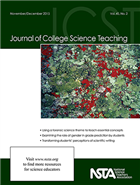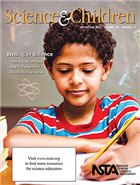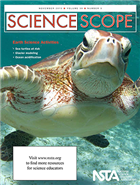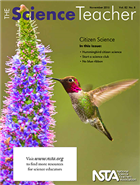NSTA’s K-College November 2015 Science Education Journals Online
By Korei Martin
Posted on 2015-11-08
Looking for ways to incorporate science and writing? Want a good look at Earth systems that are normally non-accessible? Curious about how crowd-sourcing and science go together? Do you know how middle and high school level science courses affect college students’ choice of major? The November K–college journals from the National Science Teachers Association (NSTA) have the answers you need. Written by science teachers for science teachers, these peer-reviewed journals are targeted to your teaching level and are packed with lesson plans, expert advice, and ideas for using whatever time/space you have available. Browse the November issues; they are online (see below), in members’ mailboxes, and ready to inspire teachers!
A major practice of science is the communication of ideas and the results of inquiry. The articles in this issue of S&C will help you integrate science and writing in ways that strengthen both.
Featured articles (please note, only those marked “free” are available to nonmembers without a fee):
Featured articles:
- Free – Editor’s Note: Specialized Writing
- Map It Then Write It
- Poetry Rocks!
- Programming Digital Stories and How-To Animations
- Free – Putting Ideas on Paper
- Science for Two Voices
- Free – Three-Dimensional Instruction: Using a New Type of Teaching in the Science Classroom
- Full Table of Contents
No matter where you live on this planet, you won’t have to go far to find evidence of the Earth’s systems at work. In this issue, however, we provide you with a number of ways that you can explore Earth systems at work in locations that might be outside the range of your typical field trip, such as glaciers, deep-sea platforms, and active volcanoes.
Featured articles (please note, only those marked “free” are available to nonmembers without a fee):
Featured articles:
- Free – Editor’s Roundtable: Teaching for a Dynamic Planet
- Exploring the Complexity of Ocean Acidification: An Ecosystem Comparison of Coastal pH Variability
- Modeling the Physical Properties of Glaciers
- The Ocean Platform Engineering Design Challenge: Flooded With Stem Content and Practices
- There’s a Glacier in Your Backyard: Modeling Glaciers Through Active Learning
- Free – Three-Dimensional Instruction: Using a New Type of Teaching in the Science Classroom
- Troubling Tides: Will Sea Turtles Survive the Rising Seas?
- Full Table of Contents
Citizen science harnesses the power of people by crowd-sourcing data collection and analysis. In our classes, it can create opportunities for students to participate in authentic research and the generation of new scientific knowledge. The opportunities are boundless. When students participate in citizen science projects, they go beyond canned labs where the outcome is known to discover the multidimensional nature of scientific research. Students provide essential data for important investigations, as described in this issue; they analyze data sets to discover patterns and construct explanations from evidence; they ask questions, generate and test hypotheses, and become involved in meaningful research. What better way to get students excited about science?
Featured articles (please note, only those marked “free” are available to nonmembers without a fee):
Featured articles:
- 21st-Century Citizen Science
- Free – Editor’s Corner: Citizen Science
- Free – Hummingbird Citizen Science
- No Blue Ribbon
- Start a Science Club
- Free – Three-Dimensional Instruction: Using a New Type of Teaching in the Science Classroom
- Full Table of Contents
Journal of College Science Teaching
Read about a unique project designed for an introductory-level physics course that links sustainability, arts, and scie
nce in an effort to engage students in the creative process in science. See the Research and Teaching column for a study that investigated why college-level students select science majors and how the science preparation they received in middle school and high school may have influenced their choices. Meet JCST‘s new Two-Year Community column editor, Apryl Nenortas, by reading her introduction and learning about her vision for the column.
Featured articles (please note, only those marked “free” are available to nonmembers without a fee):
Featured articles:
- Research and Teaching: Implementation of Interactive Engagement Teaching Methods in a Physical Oceanography Course
- Research and Teaching: Students’ Perceptions of Factors Influencing Their Desire to Major or Not Major in Science
- The Role of Gender in Grade Perception in Chemistry Courses
- Using Project- and Theme-Based Learning to Encourage Creativity in Science
- Free – Writing Toward a Scientific Identity: Shifting From Prescriptive to Reflective Writing in Undergraduate Biology
- Full Table of Contents
Get these journals in your mailbox as well as your inbox—become an NSTA member!
The mission of NSTA is to promote excellence and innovation in science teaching and learning for all.
Follow NSTA
Disclaimer: The views expressed in this blog post are those of the author(s) and do not necessarily reflect the official position of the National Science Teaching Association (NSTA).





